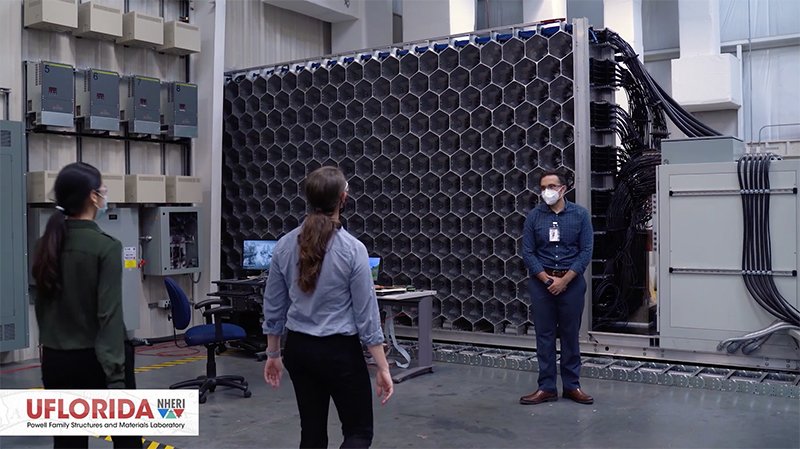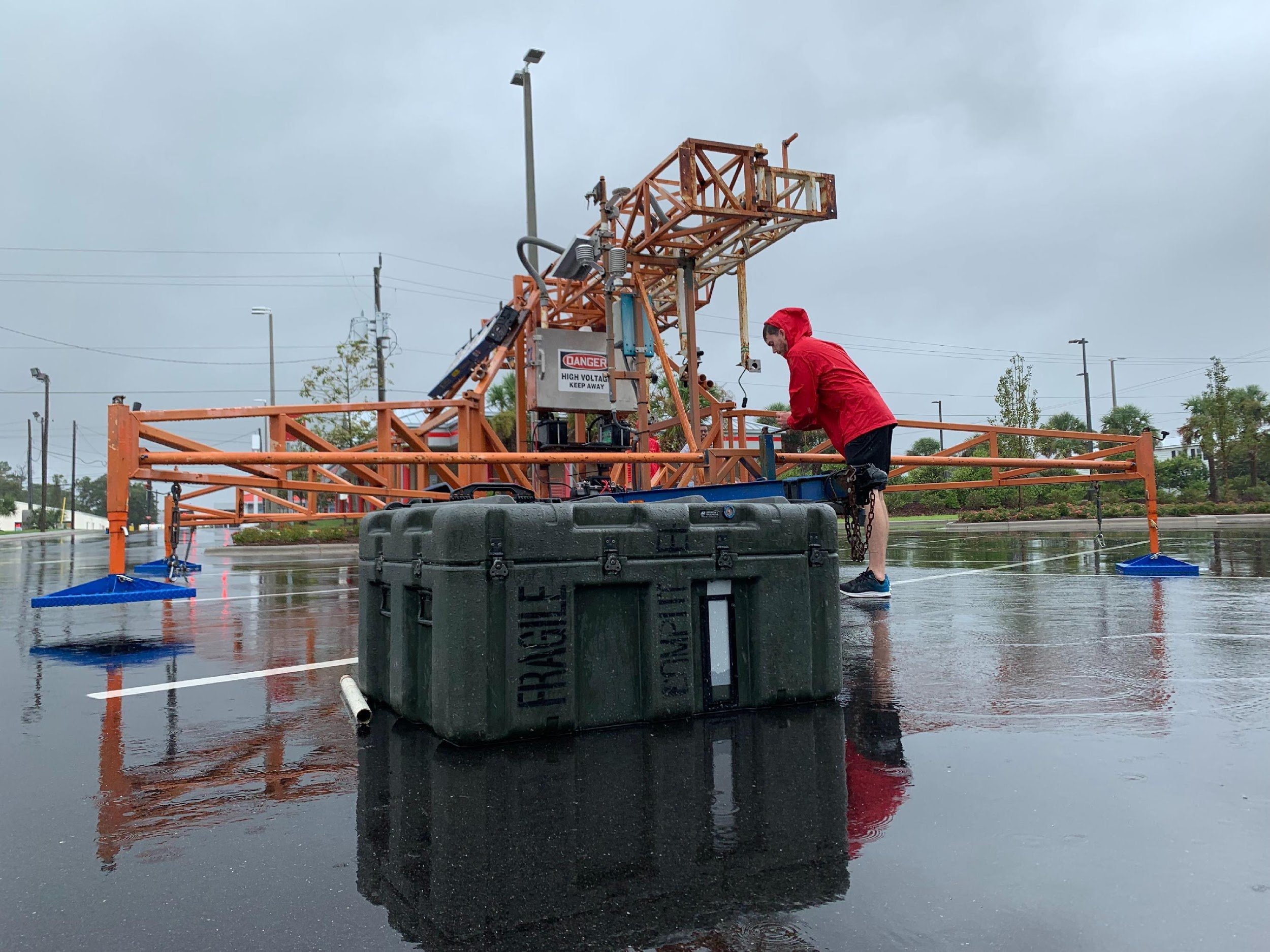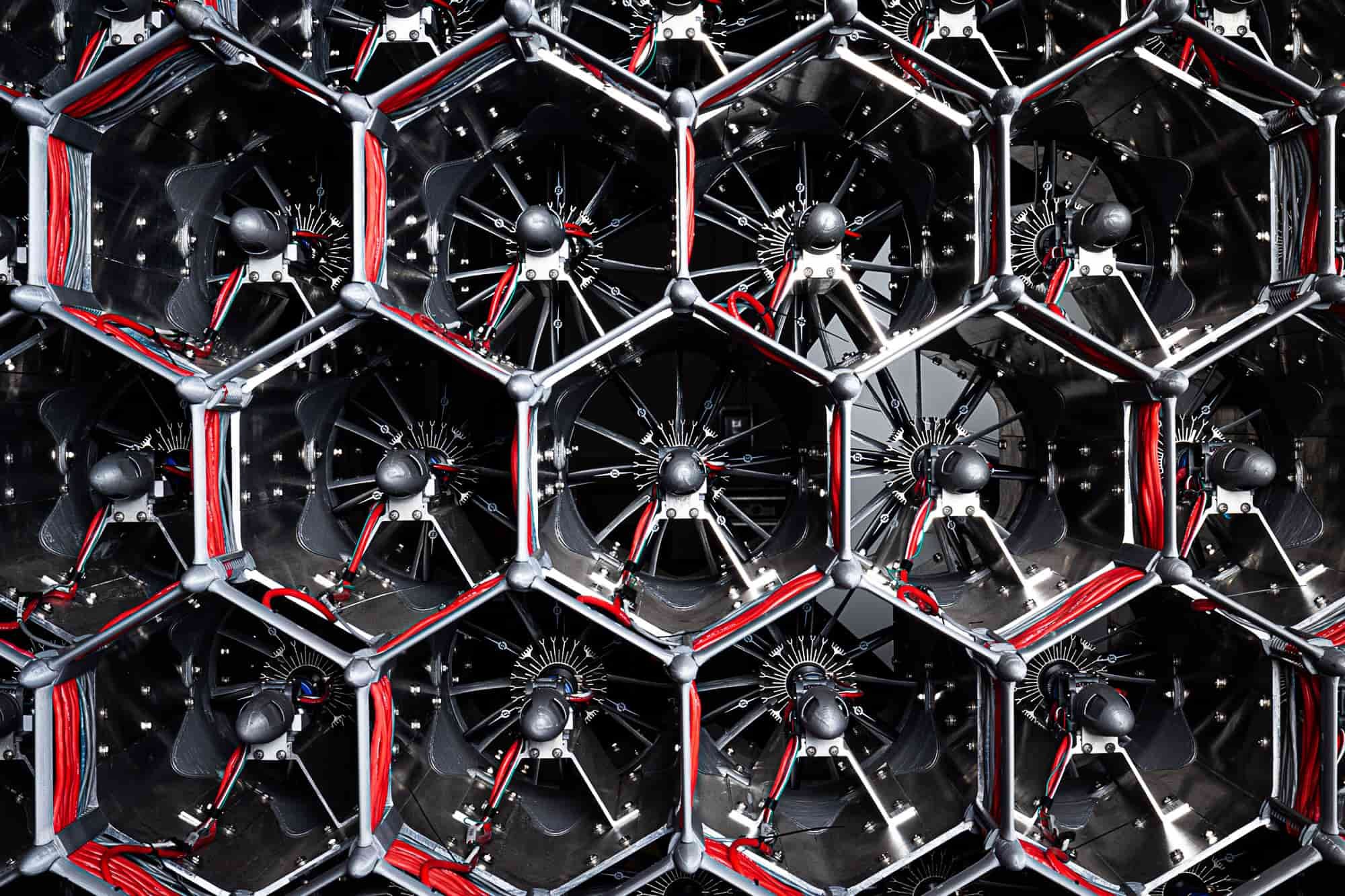FOR IMMEDIATE RELEASE
NHERI at University of Florida now simulates transient wind events
NSF-funded Flow Field Modulator adds capabilities for simulating extreme winds
Gainsville, FL, July 27, 2021 Thanks to the newly commissioned Flow Field Modulator at NHERIs University of Florida experimental facility, wind engineers can now ask questions about structural behavior during transient wind events such as downbursts and gust fronts. The NSF-funded wind tunnel facility is part of the Natural Hazards Engineering Research Infrastructure, NHERI.
As the facilitys principal investigator Jennifer Bridge describes it, the installation of the FFM is the final piece of the puzzle for the sites boundary layer wind tunnel (BLWT). The NHERI at UF site now has the additional capability for testing structural behavior during a range of extreme wind events.
The eight large fans of the existing BLWT are optimal for simulating synoptic events, which is when wind statistics remain relatively static. Researchers leverage the wind tunnels Terraformer, with 1,116 individually controllable roughness elements, to create wind profiles. Users can change element orientation and height to provide fine control over the turbulence close to the floor, where the test subjects are placed.
Nevertheless, the BLWT alone is unable to simulate transient events such as downbursts and gust fronts associated with thunderstorms. These are some of the most damaging wind phenomena, says Bridge. We want to know how these types of events impact structures, and how we can design safer structures. There are a tremendous number of open questions related to this.

The Flow Field Modulator has 319 individually controllable, high-speed fans. (Image: Unversity of Florida)
Scale matters
The FFM is a bank of 319 individually controlled, very fast fans blowing as fast as 20 meters-per-second, about 45 MPH. The individual fans can blow at different speeds and different frequencies. They can be in-phase or out-of-phase with one another. They can go in opposite directions.
For example, you can increase the wind speed down low, and reduce the speed up top, creating whats called a bullnose profile. That might look like a downburst, Bridge explains.
And its loud. You definitely need ear protection, she laughs.
NHERI at UF is not the first facility to enable testing for transient, non-synoptic events. But with 319 fans, it is the largest. Its really about the degrees of freedom we have, says Bridge. Thanks to the number of fans, plus their flexibility and responsiveness, there are endless possibilities. No other facility has the capability we now have.
Replaying time histories
As well as creating an infinite number of non-neutral wind profiles, the FFM can replay time histories of wind events. Specifically, it can recreate the field data collected by the labs storm chasing team. Led by UF professor Forrest Masters, these field researchers deploy portable weather station towers to collect wind and rain data during landfalling hurricanes, providing a wealth of data for use in wind tunnel testing.
With the FFM, users can now replay these events in the wind tunnel directly on models. The team recently demonstrated replaying winds from the 2008 Hurricane Ike and in May 2021 presented the results at a workshop on Boundary Layer Wind Tunnel Simulation of Transient and Non-Synoptic Wind Events.
Use of the FFM in tandem with the BLWT is optional. It can slide into the BLWT on rails just downwind of the main fans to provide active flow control or it can remain outside of the wind tunnel for standard BLWT operation. When the FFM is in the wind tunnel, the fan bank marries perfectly with honeycomb flow conditioning that is permanent within the BLWT.

The Flow Field Modulator can replay time histories gathered by the NHERI at UF storm-chasing team, which deploys portable weather station towers to collect wind and rain data during landfalling hurricanes. (Image: University of Florida)
UF team welcomes users
Users of all experience levels are welcome to come test out the FFM. Users unfamiliar with transient events can try the equipment, using target profiles provided by the facility. The team also invites researchers with experience testing transient wind events. Come and dig in with us, Bridge says. Our team can help investigators discover the best ways to simulate specific events and figure out how to scale a specific test.
With all the degrees of freedom available, the site team is still in the process of developing characterization data, which will be available for researchers to use in their proposals.

Close up view of the FFM, from the back. (Image: University of Florida)
Back story. While some parts for the new modulator were supplied by outside vendors, the bulk of the technology was fabricated using the Powell Laboratory 3D printers and the machine shop. Forrest Masters, the original principal investigator of the NHERI at UF facility, was the lead developer of the FFM.
The FFM came together like a very complex puzzle with tight tolerances, Bridge says. It was built from the ground up, assembling and layering the fans row by row. I think the final product is a work of art the way the cable management was done within the honeycomb framework is amazing, she adds. It had to be perfect so it aligns with the flow-conditioning honeycomb in the BLWT when its put in place.
External guidance
With such a powerful piece of equipment available to the nations wind research community, it is vital to ensure that it is configured for optimal use. We want to provide a tool with capabilities and characterization that are most useful to the community, says Bridge. To this end, the NHERI at UF team has put together a formal advisory committee.
It is a fantastic group, including some of the leaders in the field who have been working on non-synoptic simulation and data collection. This group will help the site team determine targets, the specific types of events that are key to simulate. Overall, the advisory committee will help ensure that the facility establishes repeatable, standardized wind simulations to ensure consistency in its experiments.
Among the advisory team are field data collectors, researchers who supply target wind profiles and events to simulate, and computational modelers, researchers who will use the FFM to improve their simulations. Some members of the advisory group have been involved in developing wind tunnel standards on the ASCE/SEI 49 committee. We are hoping they can bring that experience to help standardize non-synoptic wind tunnel simulation in a similar way, Bridge says.
Curious how the Flow Field Modulator can advance your research? The UF site team encourages inquiries from prospective users.
NSF Award # 1428954, MRI: Development of a Versatile, Self-Configuring Turbulent Flow Condition System for a Shared-Use Hybrid Low-Speed Wind Tunnel.
Media Contacts
Marti LaChance
Communications Manager
NHERI Network Coordination Office
nheri.communications@gmail.com
About the Natural Hazards Engineering Research Infrastructure
Funded by the National Science Foundation, the Natural Hazards Engineering Research Infrastructure, NHERI, is a network of experimental facilities dedicated to reducing damage and loss-of-life due to natural hazards such as earthquakes, landslides, windstorms, and tsunamis and storm surge. It is supported by the DesignSafe Cyberinfrastructure. NHERI provides the natural hazards engineering and social science communities with the state-of-the-art resources needed to meet the research challenges of the 21st century. NHERI is supported by multiple awards from NSF, including the NHERI Network Coordination Office, Award #1612144 and NHERI CONVERGE, Award #1841338.







